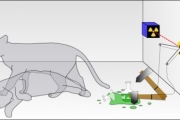Viewings: 6630

The group under the leadership of the Nile Lambert ('neill Lambert) from the Institute of physical and chemical research (RIKEN, Japan) tried to find out whether the present level of science allows us to talk about using quantum processes in biology. No, it's not about the well-known concept of quantum Darwinism. Scholars interested in the fact, whether a particular quantum mechanisms of living beings in the process of their activity.
According to supporters of quantum biology, the notorious redigerovskiy cat could use the tunnel effect. If so, in macroscopic systems quantum phenomena are not limited to superconductivity. (Fig. Wikipedia.)
The researchers analyzed advanced in recent years, examples of quantum mechanics living beings. Most of the authors are interested in Robins, has recently become a bone of contention and a centre of serious discussion. If you believe the experiments, the birds are oriented along the magnetic field lines of the Earth, only until you see the light (we are not able to organize such systems are not quantum)that makes talking about using birds of quantum entanglement to identify the lines of the magnetic field of the Earth. Trying to be objective, the researchers mentioned about the main problem of such exploitation entanglement: according to calculations, it takes a radically longer what to do in the best physical laboratories. Although the hypothesis that explains this delay, already proposed, the attitude to it in the scientific community still critical: few people like the assumption that the physics of the XXI century inferior ability to manage the quantum States ordinary Malinovka. Recall that quantum decoherence, supposedly we Robin, under normal temperature conditions is one of the most significant technical obstacles to the creation of quantum computers.
Another possible area of application of quantum mechanics biological organisms called... photosynthesis. By all indications its efficiency - up power consumption for transpiration and other auxiliary processes in the organisms of plants is much higher than would be expected, whether photosynthesis classic (aquantum) process. Scientists say: some chemical experiments, launched in 2007, shows that this suspiciously high efficiency can be explained by quantum mechanics. The obtained data appear to show the existence of quantum coherence in different pigment molecules at the time of electron transport. Definitely, when the electrons in different atoms behave coordinated as a single system, that meets the criteria of quantum processes. However, the most precise results of this kind were obtained for the temperature (77 K), not too common in photosynthesis. Other experiments, however, have shown coherent behavior of electrons and at room conditions.
However, as the authors of the review, to observe quantum effects in the pigments used for photosynthesis in the laboratory, is one thing to prove their real course in living organisms is quite another.
The tunnel effect, which, presumably, from the use of living beings of smell, is also considered to be one of the areas where living organisms are suspected of operation of quantum mechanics. Remind: according to not so long ago put forward the hypothesis, nose perceives not the shape and dimensions of molecules (built on this principle artificial olfactory detectors never gave satisfactory results)and the direct electron transfer through the tunnel effect (as in the tunnel diode) from molecules inhaled substances in nerve cell olfactory receptor.
Second suspect on the case about the tunneling effect is vision, including human. According to one hypothesis, the photon causes the molecule associated with the protein in the retina, the rapid changes in the structure, which later become a cause of secondary changes directly in the protein molecule-master. The matter is that to explain the work of view using classical mechanisms is not yet possible: in particular, artificial eye, built at a very advanced electronics, have much poorer resolution and svetochuvstvitelen than human, which forces us to look for a kind of quantum conspiracy that increase the efficiency of view in General. An experiment that could prove that, it is very difficult to be organized, though scheduled (not too close future).
Of course, sigh authors of the essay, we still know so little about all the mentioned processes that all these "inconsistencies" can be explained by a number not considered a classic processes. And yet "grounds for suspicion" is, and to resolve the issue can only special experiments in the field, which the researchers propose to call (perhaps too optimistic) quantum biology.
By the way. From the point of view of quantum Darwinism, the course of macroscopic quantum processes normally, and therefore not very clear, why should they not be in living organisms. But here's the question: how quantum processes is able to pass the threshold selection in living things?..
Report on the study published in the journal Nature Physics.
Prepared according to Ars Technica.
















